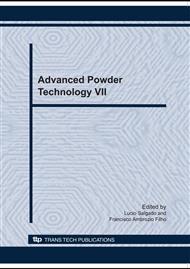[1]
P. McKendry: Bioresource Technol. Vol. 83 (2002), p.37.
Google Scholar
[2]
C. Di Blasi: Progress in Energy and Combustion Science Vol. 34 (2008), p.47.
Google Scholar
[3]
R. Bilbao, A. Millera and J. Arauzo: Thermochim. Acta Vol. 143 (1989), p.137.
Google Scholar
[4]
A. G. W. Bradbury, Y. Sakai and F. Shafizadeh: J. Appl. Polym. Sci. Vol. 23 (1979), p.3271.
Google Scholar
[5]
M. Gronli, M.J. Antal and G. Várhegyi: Ind. Eng. Chem. Res. Vol. 38 (1999), p.2238.
Google Scholar
[6]
E.L.K. Mui, W.H. Cheung, V.K.C. Lee and G. McKay: Ind. Eng. Chem. Res. Vol. 47 (2008), p.5710.
Google Scholar
[7]
M. Müller-Hagedorn and H. Bockhorn: J. Anal. Appl. Pyrolysis Vol. 79 (2007), p.136–146.
Google Scholar
[8]
R. Radmanesh, Y. Courbariaux, J. Chaouki and C. Guy: Fuel Vol. 85 (2006), p.1211–1220.
DOI: 10.1016/j.fuel.2005.11.021
Google Scholar
[9]
T.R. Rao and A. Sharma: Energy Vol. 23, (11) (1998), p.973–978.
Google Scholar
[10]
P.T. Williams and S. Besler: Fuel Vol. 72 (2) (1993), p.151.
Google Scholar
[11]
G. Várhegyi, P. Szabo and M.J. Antal Jr.: Energy & Fuels Vol. 16 (2002) p.724.
Google Scholar
[12]
C.J. Goméz, J.J. Manyà, E. Velo and L. Puigjaner: Ind. Eng. Chem. Res Vol. 43 (2004), p.901.
Google Scholar
[13]
S. Hu, A. Jess and M. Xu: Fuel Vol. 86 (2007), p.2778.
Google Scholar
[14]
J.J. Manyà and J. Arauzo: Chemical Engineering Journal Vol. 139 (2008), p.549.
Google Scholar
[15]
J.J.M. Órfão, F.J.A. Antunes and J.L. Figueiredo: Fuel Vol. 78 (1999), p.349.
Google Scholar
[16]
V. Vamvuka, E. Kakaras, E. Kastanaki and P. Grammelis: Fuel, Vol. 82 (2003), p. (1949).
DOI: 10.1016/s0016-2361(03)00153-4
Google Scholar
[17]
G. Varhegyi, M. J. Antal Jr., T. Szekely and P. Szabo: Energy & Fuels, Vol. 3 (1989), p.329.
Google Scholar
[18]
J.F. Gonzáles, J.M. Encinar, J.L. Canito, E. Sabio and M. Chacón: Journal of Analytical and Applied Pyrolysis Vol. 57 (2003), p.165.
Google Scholar
[19]
C. R. Duarte, V.V. Murata and M.A.S. Barrozo: Brazilian Journal of Chemical Engineering Vol. 22 (2005), p.263.
Google Scholar
[20]
K.G. Santos, V.V. Murata and M.A.S. Barrozo: Canadian Journal of Chemical Engineering Vol. 87 (2009), p.211.
Google Scholar
[21]
F.G. Cunha, K.G. Santos, C.H. Ataide, N. Epstein and M.A.S. Barrozo: Ind. Eng. Chem. Res. Vol. 48 (2009), p.976.
Google Scholar
[22]
H. Teng, H.C. Lin and J.A. Ho: Ind. Eng. Chem. Res. Vol. 36 (1997), p.3974.
Google Scholar


